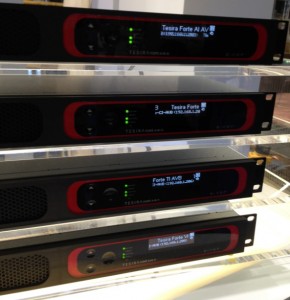Presenting live at ISE 2014 in Amsterdam today, I have the pleasure of announcing a host of new product additions and updates to the Biamp family of products. You’ve waited very patiently for our big announcements, so let’s jump in and take them one at a time.
Biamp’s New Tesira DSP
First off we have the newest addition to our DSP family: TesiraFORTÉ. As a server-class device, TesiraFORTÉ is the first AVB DSP with configurable USB audio. It comes in four different models with optional AVB networking, and is optimized for specific business applications with fixed I/O configurations.

Biamp’s new Tesira DSP: TesiraFORTE. Debuting at ISE 2014.
We built TesiraFORTÉ as an audio solution that can play in both the Everyday and Enterprise audio environments. In other words, it can be installed as a stand-alone conference room audio solution, or as a component of a much larger system. Here are the specialties of the four models:
- Standard Model for High-Quality Audio
- External Codec Conferencing Solution
- Conferencing over Standard Telephone Service Solution
- VoIP Conferencing Solution
Read more about each model and what it can do for your customers on our website, the data sheet, or the product brochure. Training for TesiraFORTÉ will begin March 3, 2014.
New Biamp Audio Networking Interface & Inputs
To continue our goal of increasing functionality and interoperability, we’ve added one new networking interface card as part of Tesira 2.0, and three inputs as part of Vocia 1.6 to our product line:
DAN-1 Dante™ Networking Card
The DAN-1 networking interface card can be installed in a Tesira SERVER alongside the AVB-1 Audio Video Bridging networking interface, and can also be installed in the SERVER-IO in various combinations with the AVB-1 and the SCM-1 CobraNet® card. Translation: Tesira devices can use Dante, CobraNet, and AVB in a single chassis. Read the data sheet for more details.
VI-8 Input
The Vocia Input 8 (VI-8) increases Vocia’s interoperability with Tesira and Audia by allowing paging audio inputs (either analog audio or CobraNet from Tesira or Audia) to be routed to any assigned page code within a Vocia world. You would use this to interface with existing non-Vocia paging stations with fireman’s mics or integrated voice evacuation modules, and interfacing with standard sound reinforcement systems. It will override everything except priority emergency pages. Read more about the VI-8 card here.
POTS-1 Input
The Vocia Telephone Paging Interface (POTS-1) allows a direct connection of two or four analog telephone service lines or POTS-based PBX telephone lines. The interface permits live paging using any page code within the Vocia system. The POTS-1 supports Vocia regular and emergency messaging, and will also support page stacking and store-and-forward functionality. Read all about it here.
VOIP-1 Input
The Vocia VoIP-1 Telephone Paging Interface acts as a SIP end point, allowing a direct connection to an existing VoIP call manager. The interface permits live paging using any page code within a Vocia system. The VoIP-1 supports Vocia regular and emergency messaging, and will also support page stacking and store-and-forward functionality. Read more about it here.
Tesira Deployment in Redundant Pairs
As part of Tesira 2.0, you can now deploy a redundant Tesira pair, or even multiple redundant pairs, with Tesira SERVER. In order to make the system work the way you need it to, we made the redundant pair a true pair. Meaning the secondary SERVER knows it needs to update itself with every change the primary SERVER makes, and it does. This way, we ensure that if a failover occurred, the sound system would behave and sound appropriately according to the last update to the primary SERVER. Read more about redundancy in Tesira SERVER here.
As usual, this is an exciting time at Biamp and we’re happy to be able to share these new additions to our product line that we think will make your jobs easier, and your installations more powerful and robust than ever before.
Stay tuned for more information about these products and updates, including blog posts about the DAN-1 card by me, and the inside of TesiraFORTÉ by our newest blog contributor, mechanical engineer Kim Porter.